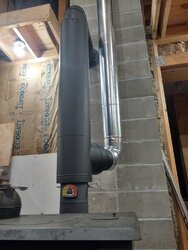I have been watching and using the forum for years but this is the first time I needed to post:
Necessary backstory:
I finished building a new off-grid workshop/home in central Maine for my family last year. The building is 3,800 sqft with tall ceilings, very well insulated and very tightly sealed. We heat exclusively with wood, no backup sources. We have a old pre-epa non-catalytic woodstove in the downstairs workshop (40' clay lined masonry chimney) and a Jotul 602 woodstove in the upstairs living quarters (20' clay lined masonry chimney). The downstairs stove is the primary stove, the upstairs is a secondary.
I heated the building exclusively with the downstairs stove last winter burning about 7 cords, our lowest outdoor temp was -27F. Both stoves have very good drafts - when they have air to draw from. The problem is that I have to crack a window open so that the stoves have a source of air to draw from since the building is so well sealed. I know this is a problem for both the stoves and for good/healthy indoor air quality. I don't want to do another season this way. Whatever I do to solve the problem cannot use much if any electricity - we are 100% solar powered, the harsh winters here can sometimes cover my solar arrays for days at a time in snow, requiring us to conserve power.
Possible solution:
I am thinking of installing a 6" insulated duct to the windward (North) side of the building, the duct would run to the downstairs woodstove, stopping short by about 5' and transitioning to a metal non-insulated duct with a manual dampener installed at the transition. The duct would join to a 8" tee with 3' long duct section above it that would be centered/wraped around my 6" single wall chimney pipe about 18" after the woodstove and in a vertical section. This would in effect create a heat exchanger that uses both the draft of the woodstove and the convection of the 1" gap of heated air between the 6" chimney and 8" duct to draw outside air into the building while simultaneously pre-heating it with waste heat.
I verified that my chimney temps in this section range between 400-500 degrees with my non-catalytic stove, and with the 40' well drafting chimney I am not too concerned about exhaust temps dropping too low to draft well or create excess creosote. If the exhaust temps drop too low I can always close the outside air dampener a bit. I am thinking that if I do this I should change my lite gauge chimney pipe in that section to a heavy gauge since I will not be able to monitor it as closely and since it will operate under harsher conditions.
I am interested in hearing thoughts on the idea?
Necessary backstory:
I finished building a new off-grid workshop/home in central Maine for my family last year. The building is 3,800 sqft with tall ceilings, very well insulated and very tightly sealed. We heat exclusively with wood, no backup sources. We have a old pre-epa non-catalytic woodstove in the downstairs workshop (40' clay lined masonry chimney) and a Jotul 602 woodstove in the upstairs living quarters (20' clay lined masonry chimney). The downstairs stove is the primary stove, the upstairs is a secondary.
I heated the building exclusively with the downstairs stove last winter burning about 7 cords, our lowest outdoor temp was -27F. Both stoves have very good drafts - when they have air to draw from. The problem is that I have to crack a window open so that the stoves have a source of air to draw from since the building is so well sealed. I know this is a problem for both the stoves and for good/healthy indoor air quality. I don't want to do another season this way. Whatever I do to solve the problem cannot use much if any electricity - we are 100% solar powered, the harsh winters here can sometimes cover my solar arrays for days at a time in snow, requiring us to conserve power.
Possible solution:
I am thinking of installing a 6" insulated duct to the windward (North) side of the building, the duct would run to the downstairs woodstove, stopping short by about 5' and transitioning to a metal non-insulated duct with a manual dampener installed at the transition. The duct would join to a 8" tee with 3' long duct section above it that would be centered/wraped around my 6" single wall chimney pipe about 18" after the woodstove and in a vertical section. This would in effect create a heat exchanger that uses both the draft of the woodstove and the convection of the 1" gap of heated air between the 6" chimney and 8" duct to draw outside air into the building while simultaneously pre-heating it with waste heat.
I verified that my chimney temps in this section range between 400-500 degrees with my non-catalytic stove, and with the 40' well drafting chimney I am not too concerned about exhaust temps dropping too low to draft well or create excess creosote. If the exhaust temps drop too low I can always close the outside air dampener a bit. I am thinking that if I do this I should change my lite gauge chimney pipe in that section to a heavy gauge since I will not be able to monitor it as closely and since it will operate under harsher conditions.
I am interested in hearing thoughts on the idea?


